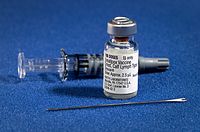
Photo from wikipedia
Clinical vaccine development and regulatory approval generally occurs in a linear, sequential manner: Phase 1: safety, immunogenicity; Phase 2: immunogenicity, safety, dose ranging, and preliminary efficacy; Phase 3: definitive efficacy,… Click to show full abstract
Clinical vaccine development and regulatory approval generally occurs in a linear, sequential manner: Phase 1: safety, immunogenicity; Phase 2: immunogenicity, safety, dose ranging, and preliminary efficacy; Phase 3: definitive efficacy, safety, lot consistency; and following regulatory approval, Phase 4: post-marketing safety and effectiveness. For candidate filovirus vaccines, where correlates of protection have not been identified, and phase 2 and 3 efficacy of disease prevention trials untenable, large and/or protracted, each trial may span decades, with full licensure expected only after several decades of development. Given the urgent unmet need for new Marburg virus and Ebola Sudan virus vaccines, the Sabin Vaccine Institute hosted a key stakeholder virtual meeting in May 2021 to explore the possibility of licensure by use of an “animal rule-like” licensure process, based on a risk/benefit assessment specific to regional needs and informed by epidemiology. This may be appropriate for diseases where there are no or limited treatment options, and those prone to sporadic outbreaks with high rates of transmission, morbidity, and mortality. The discussion focused on two contexts: licensure within the Ugandan regulatory environment, a high burden country where Ebola vaccine trials are ongoing, and licensure by the United States FDA—a well-resourced regulatory agency.
Journal Title: Vaccines
Year Published: 2022
Link to full text (if available)
Share on Social Media: Sign Up to like & get
recommendations!